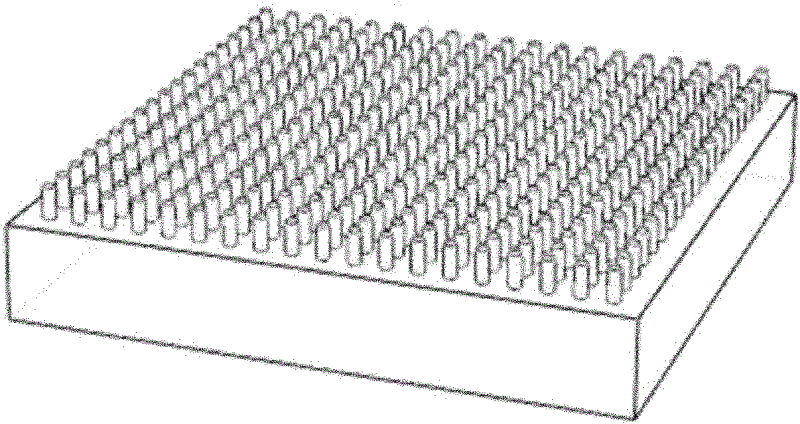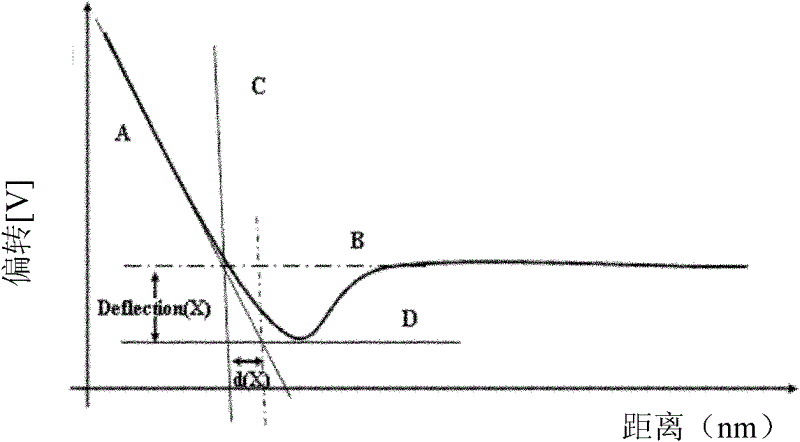Atomic force microscope probe and probe tip thereof and method for detecting capability of adhesion between helicobacter pylori and gastric mucus
An atomic force microscope, Helicobacter pylori technology, applied in the detection of Helicobacter pylori and gastric mucus adhesion ability, in the field of the needle tip of the atomic force microscope probe, to achieve the effect of convenient research
- Summary
- Abstract
- Description
- Claims
- Application Information
AI Technical Summary
Problems solved by technology
Method used
Image
Examples
Embodiment 1
[0030] (1) Express the purified adhesin BabA at a concentration of 0.5 mg / mL;
[0031] (2) Synthesis of gold particles: synthesized with reference to the method of Langmuir, 1993, 9, 2301-2309, the diameter of the obtained gold particles is 1-3 nanometers;
[0032] (3) Evenly cover the surface of Helicobacter pylori with one layer of gold particles (method with reference to CancerLetters, 2004, 209 (2), 171-176), the thickness of the covered gold particle layer is 8-10 nanometers, and the number is 10 -5 pmol / helicobacter pylori;
[0033] (4) Adhesin BabA was modified on the surface of the gold particle layer by electrostatic adsorption (refer to J.Aam.Chem.Soc.2006, 128, 2115-2120 for the modification method), and the amount of modified adhesin was 5×10 -7 pmol / helicobacter pylori;
[0034] (5) Adhere it to the distal end of the tipless atomic force microscope probe cantilever 1 with UV-curable glue. (The adhesion method refers to Front Biosci.2010, 2, 1028-41), the volume...
Embodiment 2
[0048] (1) Express the purified adhesin SabA at a concentration of 1 mg / mL;
[0049] (2) Synthesis of gold particles (method with reference to Langmuir, 1993, 9, 2301-2309), the diameter of the obtained gold particles is 1-3 nanometers;
[0050] (3) Evenly cover the surface of Helicobacter pylori with one layer of gold particles (method with reference to CancerLetters, 2004, 209 (2), 171-176), the thickness of the covered gold particle layer is 8-10 nanometers, and the number is 10 -6 pmol / helicobacter pylori;
[0051] (4) Adhesin SabA is modified on the surface of the gold particle layer by electrostatic adsorption (refer to J.Aam.Chem.Soc.2006, 128, 2115-2120 for the modification method), and the number of modified adhesin is 10 -7 pmol / helicobacter pylori;
[0052] (5) Adhere it to the distal end of the tip-free atomic force microscope probe cantilever 1 with UV-curable adhesive (refer to Front Biosci.2010, 2, 1028-41 for the adhesive method), and the thickness of the adh...
Embodiment 3
[0056] (1) Express the purified adhesin SabA at a concentration of 1 mg / mL;
[0057] (2) Synthesis of gold particles (method with reference to Langmuir, 1993, 9, 2301-2309), the diameter of the obtained gold particles is 1-3 nanometers;
[0058] (3) Evenly cover the surface of Helicobacter pylori with one layer of gold particles (method with reference to CancerLetters, 2004, 209 (2), 171-176), the thickness of the covered gold particle layer is 8-10 nanometers, and the number is 10 -4 pmol / helicobacter pylori;
[0059] (4) Adhesin SabA is modified on the surface of the gold particle layer by electrostatic adsorption (refer to J.Aam.Chem.Soc.2006, 128, 2115-2120 for the modification method), and the number of modified adhesin is 10 -6 pmol / helicobacter pylori;
[0060] (5) Adhere it to the distal end of the tipless atomic force microscope probe cantilever 1 with UV-curable glue. (For the adhesion method, refer to Front Biosci.2010, 2, 1028-41), the thickness of the glue is 0...
PUM
| Property | Measurement | Unit |
|---|---|---|
| Long trail | aaaaa | aaaaa |
| Short diameter | aaaaa | aaaaa |
| Thickness | aaaaa | aaaaa |
Abstract
Description
Claims
Application Information
 Login to View More
Login to View More - R&D
- Intellectual Property
- Life Sciences
- Materials
- Tech Scout
- Unparalleled Data Quality
- Higher Quality Content
- 60% Fewer Hallucinations
Browse by: Latest US Patents, China's latest patents, Technical Efficacy Thesaurus, Application Domain, Technology Topic, Popular Technical Reports.
© 2025 PatSnap. All rights reserved.Legal|Privacy policy|Modern Slavery Act Transparency Statement|Sitemap|About US| Contact US: help@patsnap.com



